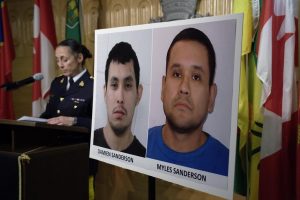Stabbing suspect not on Saskatchewan First Nation, RCMP officers say
Posted September 6, 2022 6:46 am.
Last Updated September 6, 2022 5:20 pm.
A notice sent through Saskatchewan’s emergency alert system says further investigation by RCMP has determined Myles Sanderson is not on the James Smith Cree Nation, as an earlier warning had suggested.
Sanderson, who is a suspect in a deadly series of stabbings northeast of Saskatoon over the weekend, remains at large and the alert says the public is urged to take “appropriate precautions.”
Earlier in the day Mounties surrounded a home on the James Smith Cree Nation after investigators reported receiving a report that Sanderson had been seen in the community.
Sanderson is one of two suspects in Sunday’s deadly rampage that killed 10 people and injured another 18. Officials say the 30-year-old Sanderson may be injured, adding he is considered dangerous and should not be approached.
The body of the other suspect in the attacks, 31-year-old Damien Sanderson, was discovered outdoors in a grassy area on the James Smith Cree Nation on Monday, not far from one of the crime scenes.
Leaders of the Federation of Sovereign Indigenous Nations have issued an urgent appeal to find Myles Sanderson, begging those with knowledge of his whereabouts to come forward to help end this tragedy without any more loss of life.
Since Sunday morning, police have been scouring Regina after a report the two suspects had been seen in the city, and Regina Police Chief Evan Bray says the search for Sanderson will continue until he is located or taken into custody.
RCMP has said 18 men and women were injured in the attacks, not including Myles Sanderson.
Myles Sanderson has a history of violent behaviour, document says
Myles Sanderson has a nearly two-decade-long criminal record and a propensity for violence when intoxicated, a parole board document says.
The Parole Board of Canada document from February says Myles Sanderson told the board that regular use of drugs and hard alcohol would make him “lose (his) mind” and get angry.
“Your criminal history is very concerning, including the use of violence and weapons related to your index offences and your history of domestic violence,” said the document obtained by The Canadian Press.
RCMP have not said what motivated the attacks on Sunday that left 10 people dead and 18 injured on the James Smith Cree Nation and the nearby village of Weldon, northeast of Saskatoon. Police believe some victims were targeted, but others were chosen at random.
Sanderson’s brother Damien Sanderson, also a suspect in the slayings, was found dead Monday morning on the First Nation and became the 11th fatality.
Police continue to search for Myles Sanderson, and a warrant has been issued for him on charges of first-degree murder, attempted murder and break and enter.
Sanderson received a statutory release from prison in August 2021, but it was revoked about four months later because the board said he failed to communicate with his parole supervisor.
In the document, the board said it decided to reinstate his statutory release with a reprimand.
“It is the Board’s opinion that you will not present an undue risk to society if released on statutory release and that your release will contribute to the protection of society by facilitating your reintegration into society as a law-abiding citizen.”
Sanderson was serving his first federal sentence of more than four years, four months and 19 days for a slew of offences, including assault, assault with a weapon, assaulting a peace officer and robbery. In total, the document says, he has 59 criminal convictions.
Sanderson’s childhood was marked by violence, neglect and substance abuse and led to a “cycle of substance abuse, seeking out negative peers and violent behaviour,” the document said. He lived between his father’s home in an urban centre and his grandparents’ house on a First Nation. There was violence and abuse in both households, it said.
Sanderson started drinking and smoking marijuana at around age 12 to cope with problems, the document said. Cocaine followed soon after.
“You can be easily angered when drunk but are a different person when sober,” the decision said.
The board said many of his crimes happened when he was in a state of intoxication.

Assistant Commissioner Rhonda Blackmore speaks during a press conference at RCMP “F” Division Headquarters in Regina on Sunday, Sept. 4, 2022. Damien Sanderson and Myles Sanderson allegedly stabbed and killed 10 people between James Smith Cree Nation and Weldon, Sask. on Sunday morning. Myles Sanderson is presently at large. THE CANADIAN PRESS/Michael Bell
In 2017, Sanderson went to a home where his ex-girlfriend and two children lived. The children were rushed upstairs into a bathroom and put into a tub for protection, the document said.
“You went upstairs and acted in a threatening manner, talked about the gang, and punched a hole in the bathroom door, frightening the children,” the decision said.
Sanderson fled before police arrived, but a few days later, he tried to fight a First Nation band store employee and threatened to kill him and burn down his parents’ house, the document said.
A few months later, Sanderson threatened an accomplice and forced him to rob a fast-food restaurant by hitting him in the head with a firearm and stomping on him, the decision said. Sanderson watched the robbery from outside.
In 2018, the board said Sanderson was drinking at a home and got angry with people he was with. It said he stabbed two of them with a fork, then attacked a man who was walking nearby and beat him until the man lost consciousness in a ditch.
Sanderson was located at his partner’s home two months later. During the arrest, he kicked an officer in the face and on the top of the head repeatedly, the decision said.
The board said Sanderson seemed to have maintained sobriety and obtained employment. He was taking part in cultural ceremonies and had found a home for his family. The board said it appeared he was making good progress on reintegrating with society.
The board said if he stayed sober his risk would be manageable. He was released with conditions to not contact his partner or children, except when necessary for parenting responsibilities.
In May, a Crime Stoppers bulletin was issued for Sanderson, warning he was unlawfully at large.
The Federation of Sovereign Indigenous Nations on Monday urged anyone with information about his location to contact police.
Uncertainty about the suspect’s whereabouts is causing immeasurable stress among Indigenous families, friends and neighbours, said Chief Bobby Cameron.
“They have already gone through enough,” Cameron said. “We must do everything we can to help end this tragedy without any more loss of life.”








